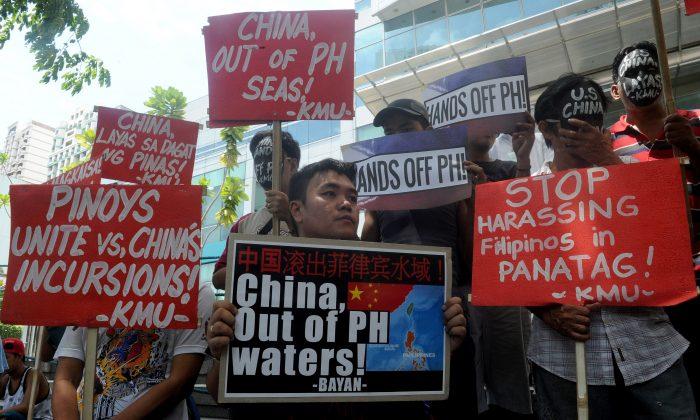An announcement by the Chinese regime on June 16 about its island building in the South China Sea is less than meets the eye. While the regime claimed its programs to build new islands in the disputed South China Sea are nearly complete, in fact it’s construction projects are merely moving into their next phase.
“This was taken as a change in policy by news outlets in the Untied States, when in reality it was not at all,” said Mira Rapp-Hooper, director of the Asia Maritime Transparency Initiative at the Center for Strategic & International Studies.
“It means they’re moving onto phase 2, which means the construction of facilities and capabilities on these islands,” Rapp-Hooper said, in a phone interview.
The Chinese Communist Party’s (CCP) announcement was a classic case of perception management. While few in the community of analysts and defense experts were fooled, several news outlets seemed to buy it.
“This statement is very much in line with what most analysts already knew,” Rapp-Hooper said.
If the CCP were making a real change, she said, “we would want to see actual changes in policy around the land features,” and as things stand now, the CCP still has dredging ships pumping sand from the sea-floor onto the man-made islands.
Playing Perceptions
Timing is important to note. The announcement came just before a Philippine lawsuit against the CCP’s land-grab was to go to trial.
“It’s just a desire by China to have the nerves calmed both in the regions and in the United States,” Rapp-Hooper said, noting China’s change in tone.
In 2013, the Philippines filed a lawsuit in the international court against the CCP, saying its claims to 90 percent of the South China Sea are invalid and violate the United Nations Convention on the Law of the Sea (UNCLOS).
Soon after the lawsuit was filed, in early 2014 the CCP started building its artificial islands.
What’s interesting, Rapp-Hooper notes, is that “all seven of the features that China is building upon are features” involved in the lawsuit the Philippines brought against China, which says the claims are illegal.
The CCP’s recent claims that its constructions are nearly finished were made just before the international court hearings in the Hague from July 7 to July 14.
Albert del Rosario, secretary of the Philippine Department of Foreign Affairs, said in a statement on the first day of the hearings that “It is a dispute that goes to the very heart of UNCLOS itself.”
Rosario said the law “does not recognize, or permit the exercise of, so called ‘historic rights,’” in areas beyond the 200-nautical mile Exclusive Economic Zones for each nation under UNCLOS.
Some of the CCP’s construction projects in the Spratly Island chain are close to 1,000 miles south of China’s southernmost point on Hainan Island.
The CCP appears to be interested in avoiding the international court altogether. It issued a “Position Paper” in December claiming the tribunal has no jurisdiction over its claims.
After the court requested input from the CCP, on July 14, Chinese authorities requested the Philippines to drop the case and to negotiate with the CCP directly.
The CCP has until Aug. 17 to comment on the hearing. A ruling is expected within 90 days.
Questionable Intent
Experts are still scratching their heads over what the CCP intends to do with the islands when they’re completed.
Between April and May, the Chinese regime was making similar attempts to alter public perception of its land-grab.
China’s navy chief Wu Shengli said during a teleconference, Reuters reported on April 30, that the CCP’s man-made islands “will improve the ability in these seas of public services like weather forecasting and maritime search and rescue,” and even said other countries could use the facilities “when conditions are right.”
At the time, much of the Western press also ran with the story, but the narrative didn’t last. Evidence soon emerged showing a clear military intent.
An artificial island the CCP is building on the Fiery Cross Reef has a 3,000 meter (10,000 feet) airstrip being laid. Rapp-Hooper said “You don’t need a 3,000 meter airstrip to land cargo planes. You need a 3,000 meter airstrip to land fighter planes.”
There were also rumors in May that the CCP had deployed mobile artillery to one of the islands, but moved it after press found out. There has also been construction of piers, docks, helipads, radar equipment, and other assets.
The odd part about the military assets on the islands, is they would be of little use in an actual war. “These islands are militarily sitting ducks,” Rapp-Hooper said. “They’re useless during wartime.”
The real value may actually be the most visible, which is simply to extend the Chinese territory—something that could stand as long as the CCP avoids an actual military conflict. The land-bases function as resupply stops for Chinese assets, and allow them to have a large and sustained military presence in the region.
By claiming the man-made islands as Chinese territory, it can then use the extended reach of its military to regulate who can and who can’t access the region.
In fact, the CCP is already using the bases for this purpose, although it hasn’t claimed an official air defense zone over the islands—like it has over Japanese-controlled territory in the East China Sea.
On May 20, the U.S. military released a video, where the Chinese military threatened a P-8 Poseidon surveillance aircraft over the audio as it flew near one of the CCP’s man-made islands.
The Chinese regime has clearly stated its ambitions in a recent defense white paper, which says it is moving its navy to an open sea doctrine.
“China is eying potential agreements with other countries that would give it some port access,” Rapp-Hooper said, noting “there is no question that China is trying to move its navy further from its shores.”
She added, “There is a clear fear that if nothing is done around this issue, China is just going to continue pushing this issue.”


![[LIVE Q&A 04/24 at 10:30AM ET] Media Raise Questions About Controversial Cloud Seeding After Middle East Floods](/_next/image?url=https%3A%2F%2Fimg.theepochtimes.com%2Fassets%2Fuploads%2F2024%2F04%2F23%2Fid5635847-CR-TN_REC_0424-1080x720.jpg&w=1200&q=75)


![[LIVE 4/26 at 10:30AM ET] New Push Started for Global Digital Currencies](/_next/image?url=https%3A%2F%2Fimg.theepochtimes.com%2Fassets%2Fuploads%2F2024%2F04%2F19%2Fid5633115-0426-1080x720.jpg&w=1200&q=75)
Friends Read Free